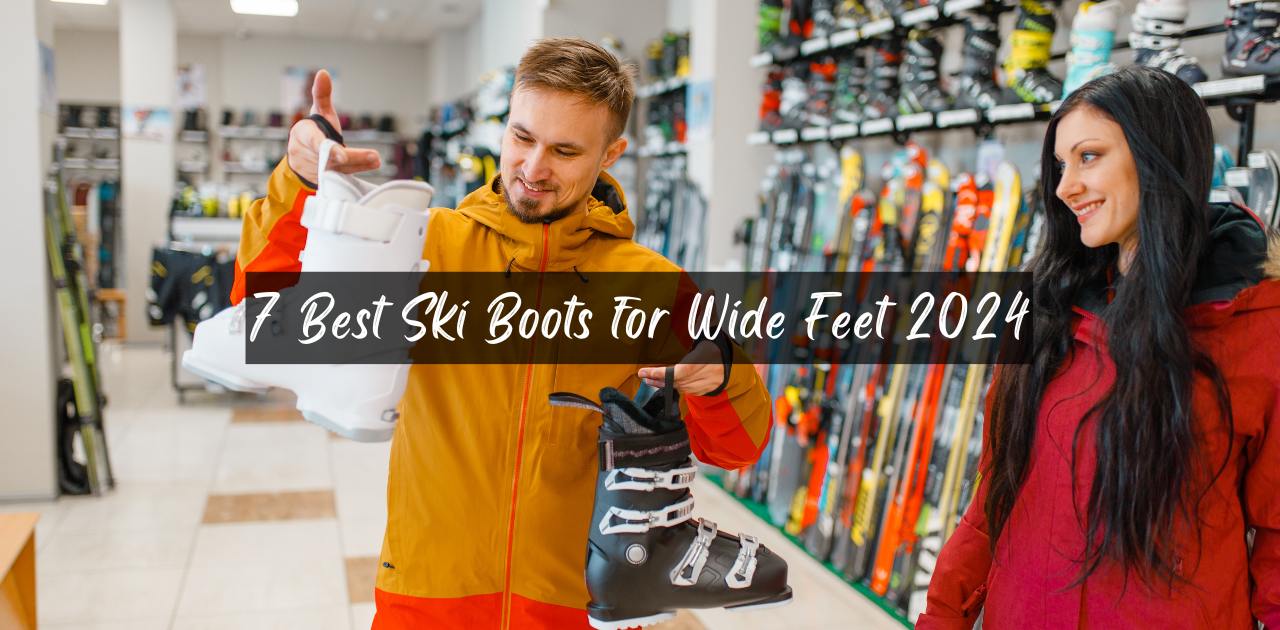Skiing is an exhilarating sport that offers a unique blend of adventure, speed, and connection with nature. But for those with wide feet, the experience can quickly turn from thrilling to uncomfortable if they don’t have the right gear. Ski boots are the critical link between the skier and the skis, playing a pivotal role in transferring energy and ensuring precise control. For individuals with wider feet, finding the perfect fit becomes even more crucial, as an ill-fitting boot can lead to discomfort, reduced performance, and even injuries.
As we approach 2024, the market is buzzing with new ski boot models, each promising enhanced features and better adaptability for wide feet. With advancements in technology and design, manufacturers are now more focused than ever on catering to the diverse needs of skiers.
This article aims to shed light on the significance of selecting the right ski boots for those blessed with broad feet and provide a sneak peek into the top picks set to dominate the slopes in 2024. Whether you’re a beginner looking for your first pair or an experienced skier seeking an upgrade, our curated list will guide you to the best choices tailored for wide feet. So, strap in and get ready to discover the ultimate ski boots that promise both comfort and peak performance for the upcoming season.
Understanding Ski Boot Fit for Wide Feet
Skiing is not just about the thrill of descending snow-covered slopes; it’s also about the intricate relationship between the skier and their equipment. Central to this relationship is the ski boot, a piece of gear that can make or break one’s skiing experience. For those with wide feet, understanding the nuances of ski boot fit is paramount.
The Challenge of Hard Plastic Shells in Ski Boots
At first glance, ski boots might appear rigid and unyielding, primarily due to their hard plastic shells. These shells are designed to provide maximum support and power transfer to the skis.
However, this rigidity can pose a challenge, especially for those with wider feet. The hard plastic doesn’t easily conform to the foot’s shape, which can lead to pressure points, discomfort, and even reduced blood circulation in extreme cases. For skiers with wide feet, this can mean a day on the slopes filled with unnecessary pain and discomfort, detracting from the joy of skiing.
The Significance of the Last Size in Determining Fit
When it comes to ski boots, one term that often pops up is “last size.” But what does it mean, and why is it crucial for wide-footed skiers? The last size refers to the width of the boot at its widest point, typically measured in millimeters. It’s a critical factor in determining how the boot will fit around the ball of the foot.
For those with wide feet, a boot with a larger last size is often more comfortable. Standard ski boots typically have a last size ranging from 97mm to 100mm. However, for those with wide feet, boots designed with a last size of 102mm or even 104mm can offer a more accommodating fit. Understanding the last size and how it relates to foot width is essential in selecting a boot that offers both comfort and performance.
In conclusion, while the hard plastic shells of ski boots can pose challenges for wide-footed skiers, understanding the significance of the last size can pave the way for a better fit. By prioritizing both comfort and performance, skiers can ensure they have the best possible experience on the slopes.
7 Best Ski Boots for Wide Feet – Top Picks for 2024
As the New Year approaches, ski enthusiasts and professionals alike eagerly anticipate the latest gear and innovations. For those with wide feet, the quest for the perfect ski boot becomes even more paramount. 2024 promises a range of ski boots tailored to cater to broader foot dimensions without compromising on performance or comfort.
In this section, we’ll delve into the crème de la crème of ski boots for wide feet, highlighting the top picks that are set to redefine skiing experiences in 2024. Whether you’re gearing up for your first skiing adventure or are a seasoned pro, these selections are sure to pique your interest.
1. Best for Beginners and Intermediates: K2 BFC 100 Ski Boots
Key Features
- 103mm last
- Moldable shells and liners
- 100 flex level
- Walk mode

The K2 BFC 100 Ski Boots are designed with both beginners and intermediate skiers in mind. Their name, BFC, stands for “Built for Comfort,” and they truly live up to this moniker. The 103mm last is a clear indication that these boots are tailored for those with wider feet, ensuring a snug yet comfortable fit. One of the standout features is the moldable shells and liners.
This means that over time, the boots will adapt to the unique shape of the wearer’s feet, providing a customized fit that enhances comfort and performance. The 100 flex level strikes a balance between flexibility and rigidity, making it ideal for those who are still honing their skiing skills but require a boot that can handle more advanced terrains.
The inclusion of a walk mode is a thoughtful addition, allowing wearers to switch between skiing and walking with ease, a feature especially appreciated during those moments when one has to navigate the ski lodge or parking areas.
Conclusion
The K2 BFC 100 Ski Boots are a testament to K2’s commitment to merging comfort with performance. They are an excellent choice for beginners and intermediates with wide feet, offering a blend of features that cater to both comfort and functionality. Whether you’re just starting out or looking to upgrade your current pair, the K2 BFC 100 should be at the top of your list.
2. Budget-Friendly Option: Dalbello DS MX 75 Ski Boots
Key Features
- 105mm last
- Soft flex rating
- Designed for downhill use

The Dalbello DS MX 75 Ski Boots are a testament to the fact that budget-friendly doesn’t necessarily mean compromising on quality. Dalbello, a brand renowned for its innovative designs and commitment to skiers, brings forth the DS MX 75 as an affordable option for those who don’t want to break the bank. With a generous 105mm last, these boots are particularly accommodating for those with wider feet, ensuring comfort without sacrificing performance.
The soft flex rating is ideal for those who prefer a more forgiving boot, especially beneficial for beginners or those who enjoy leisurely runs down groomed slopes. Designed primarily for downhill use, they provide stability and control on descents. However, potential buyers should be aware of their limitations. The DS MX 75 is not designed for off-piste or out-of-resort skiing, which means they might not be the best choice for adventurers looking to explore ungroomed terrains or backcountry areas.
Conclusion
For skiers seeking a budget-friendly option without compromising on comfort or basic functionality, the Dalbello DS MX 75 Ski Boots are a commendable choice. While they might not be suited for more rugged terrains, they excel in resort settings, making them a reliable companion for many ski enthusiasts.
3. Best for Freestyle Skiers: Full Tilt Descendant 100 Ski Boots
Key Features
- Progressive flex
- 102mm last
- Intuition liners

Freestyle skiing demands a unique blend of flexibility, support, and precision, and the Full Tilt Descendant 100 Ski Boots deliver on all fronts. Recognized for their innovative designs, Full Tilt has crafted the Descendant 100 with the freestyle skier in mind. The progressive flex ensures that the boot responds dynamically to varied pressures, allowing skiers to execute tricks, jumps, and maneuvers with enhanced control.
With a 102mm last, they cater to those with a slightly wider foot profile, ensuring a snug yet comfortable fit. One of the standout features is the inclusion of Intuition liners, known for their heat-moldable properties, which means skiers can achieve a customized fit tailored to their foot’s unique contours.
However, while the Descendant 100 boasts several impressive features, it’s essential to be aware of its limitations. The boot is on the heavier side, which might not be ideal for those who prioritize lightweight gear. Additionally, the absence of a walk mode can be a drawback for skiers who frequently transition between skiing and walking. The three-buckle design, while ensuring a secure fit, might not be everyone’s preference, especially those used to the traditional four-buckle system.
Conclusion
The Full Tilt Descendant 100 Ski Boots are a dream come true for freestyle skiers, offering a combination of features that enhance performance in the park and pipe. While they have certain limitations, their strengths in flexibility, fit, and responsiveness make them a top choice for those dedicated to the freestyle discipline.
4. Top Pick for Experienced Skiers: Atomic Hawx Magna 120s Ski Boots
Key Features
- 102mm last
- Moldable shells and liners
- Stiff flex rating
- Frictionless pivot

The Atomic Hawx Magna 120s Ski Boots are a testament to Atomic’s dedication to delivering high-performance gear for the seasoned skier. Having personally experienced the prowess of the Atomic Magna Prime 120s, the Magna 120s further elevates the skiing experience. The 102mm last ensures a snug fit, especially beneficial for those with medium to slightly wider feet.
One of the standout features is the moldable shells and liners. This adaptability ensures that the boots conform to the unique contours of the skier’s feet, providing unparalleled comfort and precision on the slopes.
The stiff flex rating is indicative of the boot’s performance-oriented design. It offers experienced skiers the rigidity they need for aggressive skiing, ensuring optimal power transfer and responsiveness. The frictionless pivot is another noteworthy feature, allowing for smoother and more natural ankle movements, enhancing the overall skiing experience.
However, like all products, the Atomic Hawx Magna 120s has its limitations. The absence of a walk mode can be a drawback for those who value the convenience of transitioning between skiing and walking, especially during off-slope moments. Additionally, the power straps, while functional, could benefit from a more robust design to ensure longevity and optimal performance.
Conclusion
For experienced skiers seeking a boot that offers a blend of comfort, precision, and high performance, the Atomic Hawx Magna 120s Ski Boots stand out as a top contender. While they have certain areas that could see improvement, their overall design and features make them a worthy investment for those dedicated to the sport.
5. Best for Backcountry Skiers – Dynafit Hoji Free 130 Backcountry Touring Boots
Key Features
- 102mm last
- Crampon and pin binding compatibility
- Adjustable cuff profile

Backcountry skiing is a realm where equipment can make a significant difference, and the Dynafit Hoji Free 130 Backcountry Touring Boots are designed with this in mind. Dynafit, a brand synonymous with mountain endurance, introduces the Hoji Free 130 as a beacon of innovation for backcountry enthusiasts. With a 102mm last, these boots cater to a wide range of foot profiles, ensuring a comfortable yet precise fit.
One of the standout features is the boot’s compatibility with both crampons and pin bindings. This dual compatibility ensures that skiers can seamlessly transition between different terrains and conditions, making the Hoji Free 130 a versatile choice for varied backcountry adventures. The adjustable cuff profile further enhances customization, allowing skiers to tweak the boot’s fit based on their preferences and the day’s demands.
When considering the price, the Dynafit Hoji Free 130 sits in the higher range. However, given its array of features, robust build, and the brand’s reputation, it offers substantial value for money. For dedicated backcountry skiers, this boot is an investment that promises to elevate their skiing experience.
Conclusion
The Dynafit Hoji Free 130 Backcountry Touring Boots are a testament to the brand’s commitment to delivering top-tier equipment for the backcountry realm. With a blend of features tailored for off-piste adventures and a design that prioritizes both comfort and performance, they stand out as a top choice for backcountry aficionados. The price might be on the higher side, but the value delivered justifies the investment.
6. Best for Telemark Skiers: Scarpa TX Pro Telemark Boots
Key Features
- 102mm last
- 110 flex rating
- Pin and tele binding compatibility

Telemark skiing, with its distinctive free-heel technique, requires boots that can offer both flexibility and support. The Scarpa TX Pro Telemark Boots are designed precisely with this balance in mind. Scarpa, a brand with a rich heritage in mountain sports, brings its expertise to the forefront with the TX Pro.
The 102mm last ensures a comfortable fit for a wide range of foot profiles. This is especially beneficial for those with a wider forefoot, as the boot provides ample space without compromising on snugness or control. The 110 flex rating strikes a balance between rigidity and flexibility, making it ideal for telemark skiers who require a dynamic response from their boots.
One of the standout features of the TX Pro is its compatibility with both pin and tele bindings. This versatility means that skiers can transition between different setups with ease, making the TX Pro a versatile choice for varied telemark adventures.
For those with a wider forefoot, the Scarpa TX Pro offers a considerate design. The spacious toe box ensures that the forefoot can rest comfortably without feeling constricted. This design consideration not only enhances comfort but also ensures optimal power transfer and control during descents.
Conclusion
The Scarpa TX Pro Telemark Boots stand out as a top choice for telemark enthusiasts. With a design that prioritizes both performance and comfort, especially for those with a wider forefoot, they promise to deliver an unparalleled skiing experience. Whether you’re carving turns on groomed slopes or exploring off-piste terrains, the TX Pro is equipped to handle it all.
7. High-Tech Option for Ski Mountaineering: La Sportiva Stratos V Alpine Ski Mountaineering Boots
Key Features
- Ultralight design
- 103.8mm last
- Specifically designed for ski mountaineering racers

For those who push the boundaries of skiing, venturing into the realms of ski mountaineering, the right equipment is not just a matter of performance—it’s a matter of safety. Enter the La Sportiva Stratos V Alpine Ski Mountaineering Boots, a high-tech marvel tailored for the most demanding alpine challenges. La Sportiva, a brand with a storied legacy in mountain sports, showcases its innovation prowess with the Stratos V.
The ultralight design of the Stratos V is its standout feature. In the demanding world of ski mountaineering, where every gram counts, this boot ensures that athletes can ascend with minimal weight without compromising on downhill performance. With a 103.8mm last, it offers a snug fit that caters to a variety of foot profiles, ensuring comfort during prolonged expeditions.
Designed with ski mountaineering racers in mind, the Stratos V is built for speed, precision, and adaptability. Its construction ensures optimal power transfer, allowing racers to navigate challenging terrains with confidence.
When considering the price, the La Sportiva Stratos V is undoubtedly a premium option. However, its specialized design, cutting-edge technology, and focus on ski mountaineering racing justify the investment. It’s essential to note that this boot is tailored for specialized use, making it ideal for seasoned ski mountaineers and racers.
Conclusion
The La Sportiva Stratos V Alpine Ski Mountaineering Boots are a testament to what’s possible when innovation meets expertise. For ski mountaineering racers and enthusiasts seeking the pinnacle of technology and performance, the Stratos V stands in a league of its own. While it comes with a premium price tag, the unparalleled features and specialized design make it a worthy investment for those dedicated to the sport.
Shopping Guide for Ski Boots
Selecting the right ski boots is a crucial decision that can significantly impact your skiing experience. Whether you’re a novice or a seasoned pro, understanding the various factors that go into choosing the perfect pair is essential. In this shopping guide, we’ll delve into the key considerations you should keep in mind when on the hunt for your next pair of ski boots.
Factors to Consider
Cost
Ski boots come in a wide range of prices, and often, the cost is reflective of the features and technicalities the boot offers. While budget-friendly options can provide basic functionality, premium boots often come equipped with advanced features, materials, and technologies. It’s essential to strike a balance between your budget and the features you deem necessary for your skiing adventures.
Fit
The fit of a ski boot can make or break your skiing experience. Moldable shells and liners have become increasingly popular, allowing for a customized fit tailored to the unique contours of your feet. Additionally, understanding the last size of a boot is crucial. The last size, typically measured in millimeters, indicates the width of the boot at its widest point. Ensuring a proper fit can prevent discomfort and potential injuries.
Discipline
Different skiing styles and terrains require specific boot designs. Whether you’re into alpine skiing, freestyle, backcountry, or telemark, it’s vital to match your boots to your preferred discipline. Each style has unique demands, and the right boot can enhance performance and safety.
Stiffness
Flex ratings indicate the stiffness of a ski boot. Lower flex ratings (e.g., 60-80) are more forgiving and suitable for beginners, while higher flex ratings (e.g., 100-130) offer more rigidity, ideal for experienced skiers who demand precision and power. Understanding your skill level and the implications of different flex ratings is crucial in selecting the right boot.
Brand Reputation
While features and specifications are essential, the reputation of a ski boot brand shouldn’t be overlooked. Established brands with a history of producing quality products can be a reliable choice. Researching reviews, seeking recommendations, and understanding the brand’s legacy can guide you towards a trustworthy purchase.
Conclusion
Investing in the right ski boots is an investment in your skiing experience. By considering factors like cost, fit, discipline, stiffness, and brand reputation, you can ensure that you’re equipped with the best gear for your needs. Whether you’re carving turns on groomed slopes or venturing into the backcountry, the right boots will enhance your performance, comfort, and safety.
The Role of a Boot Fitter
When it comes to skiing, the right equipment can elevate your experience, and at the heart of this equipment lies the perfect pair of ski boots. While research and understanding can guide you towards a good choice, consulting with a boot fitter can make all the difference.
A boot fitter is a professional trained to assess your foot’s unique shape, size, and needs, ensuring that you get a ski boot that fits like a glove. Their expertise goes beyond just size; they understand the nuances of different brands, models, and the specific requirements of various skiing disciplines.
One of the primary benefits of working with a boot fitter is the ability to mold and adjust boots for a perfect fit. While many modern ski boots come with moldable liners, a boot fitter can further tweak and adjust the shell, ensuring that pressure points are eliminated and that your foot is snugly cradled.
Also Read: Best Espresso Machines Under $200
Common Questions about Wide Ski Boots
What does “wide fit” mean in ski boots?
A “wide fit” in ski boots typically refers to boots designed with a broader last or width, catering to individuals with wider feet. This ensures comfort without compromising on performance.
How do I understand the “last” or width of a ski boot?
The “last” of a ski boot is a measurement, usually in millimeters, indicating the boot’s width at its widest point. It gives an idea of the boot’s overall volume and how it might fit your foot.
Can I adjust and mold my ski boots for a better fit?
Absolutely! Many modern ski boots come with moldable liners, and some even have shells that can be adjusted. This allows for a more customized fit, tailored to the unique contours of your feet.
What should I expect from new ski boots in terms of the break-in period?
New ski boots might feel a bit snug or even uncomfortable initially. However, as you wear them, the liners will start to mold to your feet, and the shells might give a little. This break-in period can vary but usually lasts a few days of skiing.
How do I decide between stiff and soft flex boots?
Your choice between stiff and soft flex boots should be based on your skiing style and experience. Beginners might benefit from a softer flex, offering more forgiveness, while advanced skiers often prefer stiffer boots for precision and control.
Conclusion 2024 promises to be an exciting year for skiers with wide feet, with numerous top-notch options available. While the choices are plenty, the emphasis remains on finding the right fit and prioritizing comfort. Remember, the perfect ski boot is a blend of fit, function, and personal preference. And when in doubt, always turn to professionals like boot fitters to guide you towards the best decision. Happy skiing!







